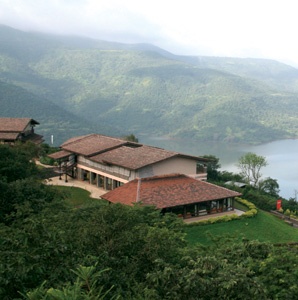 Not far from Mumbai, one man is creating what may be the green city of the future.
Not far from Mumbai, one man is creating what may be the green city of the future.
Indian industrialist Ajit Gulabchand has spent the past eight years developing a hill station, a leafy mountain retreat of the sort that India hasn’t built since the British departed in 1947. An imposing man of 61, with a full head of gray hair, Gulabchand—whose Hindustan Construction Company is best known for the Bandra-Worli Sea Link, a 3 1/2-mile-long bridge joining Mumbai to its western suburbs—habitually talks about the fledgling city, Lavasa, in the jargon of New Urbanism, a planning movement that has its roots in 1980’s Florida. “The idea is a Transect model, where it’s very high density,” he explains, using a term coined by Miami-based architect (and New Urbanist icon) Andrés Duany. “Seventy percent of our population would be in walking distance from one another.”
Strange that a developer from India would look to the United States to achieve population density, something you’d think his own country had pretty much invented. But Gulabchand points out that the new sections of Indian cities such as Delhi tend to sprawl. And while Western travelers go to India to immerse themselves in a culture that’s thousands of years old, India’s increasingly educated, prosperous young people—Gulabchand’s target audience—tend to want livability and comfort. “So the question becomes, How do we innovate, so that prosperity can come with much less carbon?” Gulabchand is creating India’s city of the future.
He’s turned to HOK, a St. Louis–based architecture firm, and a string of American consultants to conjure up a city of 200,000 near Pune, in the state of Maharashtra, that will embody pretty much every au courant strategy intended to undo the bad habits of the late 20th century. Lavasa’s design will be based not just on the principles of New Urbanism but also on biomimicry, in which man-made things are shaped using nature’s methods.
Lavasa’s site, largely deforested, has been replanted with nearly a million trees, meant to naturally replenish and maintain the area’s water table and create the kind of shady outpost the British once cherished. It will be built with low energy consumption and water conservation in mind. The architecture will be of mixed provenance: the breezy vernacular of India’s Malabar Coast, Mumbai’s social housing, and even Mediterranean style. “Nothing will be a copy,” Gulabchand stresses. “It has to be an inspiration. Copies can look like Disneyland.”
To lure the permanent residents necessary for a real city, Lavasa has made room for educational institutions, including an outpost of the Swiss hospitality school École Hôtelière de Lausanne and Saïd Business School, a branch of the University of Oxford. Among other things, Gulabchand wants Lavasa to be an educational hive like Cambridge, Massachusetts.
But he’d also like to draw some 2 million tourists a year, primarily from nearby Mumbai and Pune. By the end of 2010 the development will feature a variety of hotels, including a Novotel and a Mercure, both owned by the French hotel group Accor. A 60-room branch of the Indian Fortune Park Hotels chain has opened its doors, and the first of Lavasa’s four enclaves—Dasve, a multicolored string of Portofino-influenced apartments and cafés along a lakefront promenade—nears completion. The Ekaant, a rustic 20-room lodge located in the hills above the town center, is now accepting guests; the town also has a NASA-themed space camp, academy, and mall in the works, as well as a branch of the MGM Studios theme park with both Hollywood- and Bollywood-related attractions. “Without Bollywood it would not work,” Gulabchand notes. A watersports center will be on the banks of Lavasa’s Warasgaon Lake, with a Nick Faldo–branded golf course nearby. Apollo, an Asian hospital chain, is opening a 200-bed facility to serve the needs of residents, plus a special clinic designed to cater to medical tourists.
What will likely be a popular weekend escape for upscale Mumbai residents may also turn out to be a draw for those of us who live much farther away. Gulabchand suggests that Lavasa’s location makes it an attractive jumping-off point into the ecologically significant Western Ghats mountain range. Perhaps more important, Lavasa stands as a model for a new kind of international city, rooted in place and local culture, but at the same time plugged into global currents of green design and upward mobility.
Master Plan: Foster & Partners
A $22 billion, 2.3-square-mile, car-free, carbon-neutral city and a test of whether alternative energy sources like solar and wind power—and lots of shade—can keep a desert city cool. masdarcity.ae. Scheduled completion date of phase one: 2013.
Master Plan: Kohn Pedersen Fox
This 1,500-acre, energy-efficient waterfront business and residential district will eliminate the need for garbage trucks with a pneumatic waste-transfer system and feature a Paris-inspired bike-lending system. songdo.com. Scheduled completion date: 2017.
Master Plan: Skidmore, Owings & Merrill
The mixed-use plan for an island in San Francisco Bay includes futuristic high-rise towers, low-rise residential districts, solar and wind power, and a 20-acre organic farm. som.com. Scheduled completion date: within 20 years.
Master Plan: Arup and the Beijing Urban Planning & Design Institute
Arup, the global engineering firm, has mapped out several Chinese eco-cities, including the 1,235-acre project in Fengtai, near Beijing, where an eco-industrial park is part of the mix. arup.com. Scheduled completion date: unknown, pending approval.